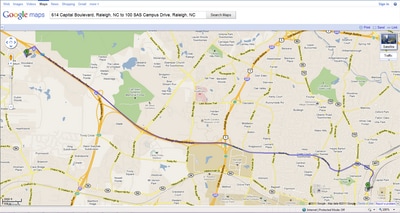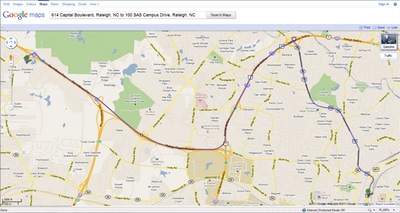The Network Solver
- Overview
- Getting Started
-
Syntax

-
Details
 Input Data for the Network SolverSolving over Subsets of Nodes and Links (Filters)Numeric LimitationsBiconnected Components and Articulation PointsCliqueConnected ComponentsCycleLinear Assignment (Matching)Minimum-Cost Network FlowMinimum CutMinimum Spanning TreeShortest PathTransitive ClosureTraveling Salesman ProblemMacro Variable _OROPTMODEL_
Input Data for the Network SolverSolving over Subsets of Nodes and Links (Filters)Numeric LimitationsBiconnected Components and Articulation PointsCliqueConnected ComponentsCycleLinear Assignment (Matching)Minimum-Cost Network FlowMinimum CutMinimum Spanning TreeShortest PathTransitive ClosureTraveling Salesman ProblemMacro Variable _OROPTMODEL_ -
Examples
 Articulation Points in a Terrorist NetworkCycle Detection for Kidney Donor ExchangeLinear Assignment Problem for Minimizing Swim TimesLinear Assignment Problem, Sparse Format versus Dense FormatMinimum Spanning Tree for Computer Network TopologyTransitive Closure for Identification of Circular Dependencies in a Bug Tracking SystemTraveling Salesman Tour through US Capital Cities
Articulation Points in a Terrorist NetworkCycle Detection for Kidney Donor ExchangeLinear Assignment Problem for Minimizing Swim TimesLinear Assignment Problem, Sparse Format versus Dense FormatMinimum Spanning Tree for Computer Network TopologyTransitive Closure for Identification of Circular Dependencies in a Bug Tracking SystemTraveling Salesman Tour through US Capital Cities - References
This section shows an introductory example for getting started with the network solver. For more information about the expected input formats and the various algorithms available, see the sections Details: Network Solver and Examples: Network Solver.
Consider the following road network between a SAS employee’s home in Raleigh, NC, and the SAS headquarters in Cary, NC.
In this road network (graph), the links are the roads and the nodes are intersections between roads. For each road, you assign
a link attribute in the variable time_to_travel to describe the number of minutes that it takes to drive from one node to another. The following data were collected using
Google Maps (Google 2011):
data LinkSetInRoadNC10am; input start_inter $1-20 end_inter $20-40 miles miles_per_hour; datalines; 614CapitalBlvd Capital/WadeAve 0.6 25 614CapitalBlvd Capital/US70W 0.6 25 614CapitalBlvd Capital/US440W 3.0 45 Capital/WadeAve WadeAve/RaleighExpy 3.0 40 Capital/US70W US70W/US440W 3.2 60 US70W/US440W US440W/RaleighExpy 2.7 60 Capital/US440W US440W/RaleighExpy 6.7 60 US440W/RaleighExpy RaleighExpy/US40W 3.0 60 WadeAve/RaleighExpy RaleighExpy/US40W 3.0 60 RaleighExpy/US40W US40W/HarrisonAve 1.3 55 US40W/HarrisonAve SASCampusDrive 0.5 25 ;
Using the network solver, you want to find the route that yields the shortest path between home (614 Capital Blvd) and the SAS headquarters (SAS Campus Drive). This can be done by using the SHORTPATH= option as follows:
proc optmodel;
set<str,str> LINKS;
num miles{LINKS};
num miles_per_hour{LINKS};
num time_to_travel{<i,j> in LINKS} = miles[i,j]/ miles_per_hour[i,j] * 60;
read data LinkSetInRoadNC10am into
LINKS=[start_inter end_inter]
miles miles_per_hour
;
/* You can compute paths between many pairs of source and destination,
so these parameters are declared as sets */
set HOME = /"614CapitalBlvd"/;
set WORK = /"SASCampusDrive"/;
/* The path is stored as a set of: Start, End, Sequence, Tail, Head */
set<str,str,num,str,str> PATH;
solve with network /
links = ( weight = time_to_travel )
shortpath = ( source = HOME
sink = WORK )
out = ( sppaths = PATH )
;
create data ShortPath from [s t order start_inter end_inter]=PATH
time_to_travel[start_inter,end_inter];
quit;
For more information about shortest path algorithms in the network solver, see the section Shortest Path. Figure 9.1 displays the output data set ShortPath, which shows the best route to take to minimize travel time at 10:00 a.m. This route is also shown in Google Maps in Figure 9.2.
Now suppose that it is rush hour (5:00 p.m.) and the time to traverse the roads has changed because of traffic patterns. You want to find the route that is the shortest path for going home from SAS headquarters under different speed assumptions due to traffic.
The following statements are similar to the first network solver run, except that one miles_per_hour value is modified and the SOURCE= and SINK= option values are reversed:
proc optmodel;
set<str,str> LINKS;
num miles{LINKS};
num miles_per_hour{LINKS};
num time_to_travel{<i,j> in LINKS} = miles[i,j]/ miles_per_hour[i,j] * 60;
read data LinkSetInRoadNC10am into
LINKS=[start_inter end_inter]
miles miles_per_hour
;
/* high traffic */
miles_per_hour['Capital/WadeAve','WadeAve/RaleighExpy'] = 25;
/* You can compute paths between many pairs of source and destination,
so these parameters are declared as sets */
set HOME = /"614CapitalBlvd"/;
set WORK = /"SASCampusDrive"/;
/* The path is stored as a set of: Start, End, Sequence, Tail, Head */
set<str,str,num,str,str> PATH;
solve with network /
links = ( weight = time_to_travel )
shortpath = ( source = WORK
sink = HOME )
out = ( sppaths = PATH )
;
create data ShortPath from [s t order start_inter end_inter]=PATH
time_to_travel[start_inter,end_inter];
quit;
Now, the output data set ShortPath, shown in Figure 9.3, shows the best route for going home at 5:00 p.m. Because the traffic on Wade Avenue is usually heavy at this time of day,
the route home is different from the route to work.
This new route is shown in Google Maps in Figure 9.4.

